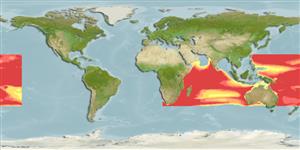>
Stomiiformes (Lightfishes and dragonfishes) >
Stomiidae (Barbeled dragonfishes) > Astronesthinae
Etymology: Astronesthes: Greek, astra = ray + Greek, esthes, -es = suit, something used to wrap (Ref. 45335).
Environment: milieu / climate zone / depth range / distribution range
Ecologia
marino batipelagico; distribuzione batimetrica 50 - 2230 m (Ref. 58302). Deep-water; 25°N - 37°S, 15°E - 154°W
Indo-Pacific: Its range seems to represent the equatorial distributional pattern; it expands southwards in the western parts of the Pacific (including the Philippine Sea, Ref. 41299), and Indian oceans; absent in the eastern part. Atlantic Ocean: Present in a small portion near southern Africa.
Size / Peso / Age
Maturity: Lm ? range ? - ? cm
Max length : 20.8 cm SL maschio/sesso non determinato; (Ref. 27676)
Short description
Morfologia | Morfometria
Spine dorsali (totale): 0; Raggi dorsali molli (totale): 14-17; Spine anali 0; Raggi anali molli: 12 - 16; Vertebre: 43 - 46. Last photophore of VAL series behind origin of anal and last photophore of VAV series. Aggregation of luminous tissue on head, when fully developed fish > 10 cm SL, forming transverse bar across gill cover; longitudinally oriented aggregations of luminous tubercle-like spots on body behind head and above pelvic fins. In immature fish < 6 cm SL, chin barbel fully developed, longer than head, its swollen tip forming elongate thickened rod with two flattened distal lobes (Ref. 27676).
Epi- and mesopelagic, with fishing depths to 4000 m (Ref. 58302). Found on the continental slope (Ref. 75154).
Life cycle and mating behavior
Maturità | Riproduzione | Deposizione | Uova | Fecundity | Larve
Parin, N.V. and O.D. Borodulina, 1996. Revision of the Astronesthes indicus species group (Astronesthidae), with descriptions of five new species. J. Ichthyol. 36(8):551-565. (Ref. 27676)
IUCN Red List Status (Ref. 130435)
Threat to humans
Harmless
Human uses
Informazioni ulteriori
Nomi ComuniSinonimiMetabolismoPredatoriEcotossicologiaRiproduzioneMaturitàDeposizioneSpawning aggregationFecundityUovaEgg development
Age/SizeAccrescimentoLength-weightLength-lengthLength-frequenciesMorfometriaMorfologiaLarveDinamica popolazioni larvaliReclutamentoAbbondanzaBRUVS
BibliografiaAcquacolturaProfilo di acquacolturaVarietàGeneticaElectrophoresesEreditarietàMalattieElaborazioneNutrientsMass conversion
CollaboratoriImmaginiStamps, Coins Misc.SuoniCiguateraVelocitàModalità di nuotoArea branchialeOtolithsCervelliVista
Strumenti
Special reports
Download XML
Fonti Internet
Estimates based on models
Preferred temperature (Ref.
123201): 4.7 - 12.4, mean 7.4 °C (based on 498 cells).
Phylogenetic diversity index (Ref.
82804): PD
50 = 0.5000 [Uniqueness, from 0.5 = low to 2.0 = high].
Bayesian length-weight: a=0.00417 (0.00171 - 0.01014), b=3.05 (2.83 - 3.27), in cm total length, based on LWR estimates for this (Sub)family-body shape (Ref.
93245).
Trophic level (Ref.
69278): 4.0 ±0.6 se; based on size and trophs of closest relatives
Resilienza (Ref.
120179): Medio, tempo minimo di raddoppiamento della popolazione 1.4 - 4.4 anni (Preliminary K or Fecundity.).
Fishing Vulnerability (Ref.
59153): Low vulnerability (15 of 100).
